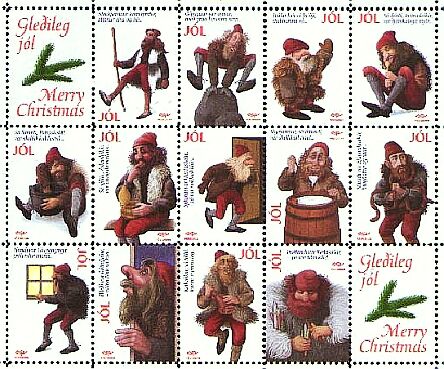|
|
|
|
In the past, the Yule season could not be one of excess and consumption due to the island nation's poverty. Instead, December became a time of the family working together to produce wool goods to be bartered for Christmas supplies. In modern times, Iceland is much more prosperous and Christmas is a merrier season. December 23rd is St. Thorlakur's Day named for Saint Thorlakur Thorhallsson, who was the 12th century Bishop of Skálholt. He is Iceland's patron saint and was canonized by Pope John Paul II in 1985. The main tradition associated with Ţorláksmessa is the serving of a kind of odiferous skate hash. While it may be served, that doesn't mean it is eaten by everyone. It is said to be so unappetizing that it makes subsequent holiday dining a real treat for the taste buds. The tradition of eating this peculiar and smelly food (it has a strong odor of ammonia) arose in the West Fjords and has slowly spread all over the countryside. The custom of eating fish on Ţorláksmessa began when it was the last day of the Catholic Christmas fast when people weren't permitted to eat meat. The tradition continued after the country converted to the Lutheran faith since it was a busy day, and the meal needed to be easily prepared amidst all the hustle and bustle. St. Thorlakur's Day is usually the day that the tree is trimmed and last minute shopping is accomplished. Many stores and shopping areas remain open until midnight. Jól celebrations begin at 6 p.m. on Ađfangadagur or Christmas Eve. Often, the family attends a church service and then they return home for a special dinner. The meal is based around Hangikjöt, smoked mutton, or Rjúpa, rock ptarmigan. Jólagrautur, a rice porridge with raisins is also part of the meal. There is a lucky almond in the jólagrautur, a Christmas tradition that is also found in other Scandinavian nations. Laufabrauđ or leaf-bread is a deep-fried, thin, wheat bread that is traditionally cut with intricate decorative patterns. The custom began in the northern part of Iceland, but has spread throughout the island. In modern times, laufabrauđ is ready-made in bakeries or it can be bought uncooked, pre-kneaded and cut at a grocery store. Some people have started making snacks from the laufabrauđ by cutting it into strips and frying. It takes the place of potato chips and nachos. Christmas traditions have been intermingled with ancient Yule tradition of the winter solstice. These traditions can be found in the Icelandic Sagas. Medieval writings tell of Yule celebrations held in conjunction with Christmas. One of the most interesting seasonal legends is that of the sinister and gargantuan Jólaköttur or Yule Cat that supposedly came from other Nordic nations. The dreaded cat is ready to pounce on lazy humans and devour them. Anyone who did not do their part in helping the village to finish the work that needed to be done on the autumn wool before Christmas time would miss out on the reward of a new article of clothing, and they might end up as a meal for the monstrous cat.  Iceland's landscape is also haunted by several holiday ogres and their offspring. Grýla and her mate Leppalúđi are flesh-eating monsters who have thirteen children known as Jólasveinar or Yule Lads. The mischievous youngsters come down from the mountains, one by one, and visit homes beginning on December 12th. By Christmas Day, they've all arrived and, according to legend, have made life miserable for the inhabitants. Each Yule Lad has a specialty. For example, Meat Hooker steals the roast from the refrigerator, Door Slammer slams doors in the middle of the night and Window Peeper can be seen peeking through the curtains after the household has gone to bed. In addition, for 13 days, if the children have been good, one of these lads will leave a gift in the children's shoes which are placed on the windowsill. If the children have been bad the lads leave a potato or other reminder that gifts are for good children. The Jólasveinar start returning to the mountains on Christmas Day, one each day until the last one departs on January 6th. Icelandic television goes off the air on Christmas Eve from 5 until 10 p.m. so that families can spend the time dining together followed by the opening of gifts. Christmas Day, Jóladagur, and Boxing Day, Annar
Jóladagur, bring on more feasting, visiting, and parties. The season
ends on January 6 when bonfires burn the holiday refuse and fireworks are set off.
|